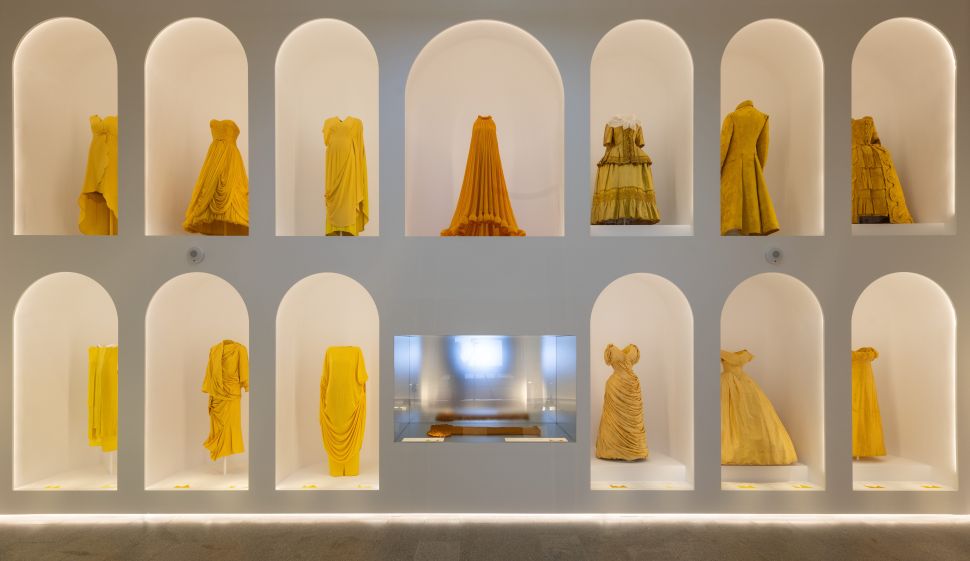
If I had to sum up this exhibition in one word, that word would be congested. “Sleeping Beauties: Reawakening Fashion” at the Met’s Costume Institute has more than 200 pieces on view in 29 rooms—many displayed in glass cases like Sleeping Beauty, the famous sleeping princess who could only be awakened by her true love’s kiss, but it’s less romantic than it sounds. The hallways are so narrow and the pit-stop rooms so tiny that you can’t help but bump into your fellow fashion lovers—especially as they pause to snap pics.
Surprisingly, this is the case even though the way “Sleeping Beauties” is organized is that visitors scan a QR code once inside the museum to join a “virtual waitlist” to enter the exhibition. If you’re a museum member ($110 per year for an individual), you can enter the exhibition in 10 minutes or less. If you’re not a member, the typical wait time in the exhibition’s opening week was a glacial three hours. Thus, we have a $110 exhibition on our hands. Worth it? Probably not, but it’s a surefire way to sell memberships.

Inside, this exhibition has the feel of A Midsummer’s Night Dream about it, with leafy fashion, floral prints, botanical embroidery and fairytale-friendly fare with pieces by Cristóbal Balenciaga, Hattie Carnegie, Lilly Daché, Hubert de Givenchy, Deirdre Hawken, Stephen Jones, Guy Laroche, Madame Pauline, Mainbocher, Elsa Schiaparelli and Sally Victor, among others.
At its best, “Sleeping Beauties” showcases otherworldly pieces by Iris Van Herpen and treasures from the archives of Alexander McQueen—who can forget his iconic monarch butterfly dress, which is actually made from feathers? At its worst, the exhibition has ghastly, floral hats with huge brims—the type of things your great-grandmother might be forced to wear for propriety’s sake. Completely hideous. Overall, there’s so much to take in and it’s such a detail-heavy show that you could easily spend hours here, though you may be tempted to speedwalk through certain sections.

The ‘sleeping beauties’ are sixteen special garments too fragile to be dressed on mannequins, which is a shame. These garments are displayed laid flat in glass coffins and they, to be honest, do feel quite dead. Looking at an old dress on a mannequin brings it back to life because on a human form, one can imagine it out in the world. When laid flat, even the most gorgeous gown looks a little like laundry. Fabulous though they may be, the pieces might best be described as couture corpses or zombie fashion.

While the sleeping beauties are not exactly thrilling to behold, there is a fun twist to the exhibition: each garment connects to nature, thematically or materially, and nature, as a metaphor, represents the transient essence of fashion (the four seasons can be applied to fashion’s circularity). Motifs like flowers, foliage, birds, insects, shells and fish are divided into three groupings: earth, air and

Florals in fashion are practically a proverb—so typical it can be hard to find meaning in floral hats, dresses or scarves, all age-old in their style. But nonetheless, the silk cape designed by Alessandro Michele for Gucci’s 2017-18 autumn/winter collection, which has a bit of a retro Elvis glam vibe to it, is one highlight of the exhibition.
The 18th-century French dresses are another, as is a sequin dress by Mary Katrantzou from 2018. There are Rodarte dresses, a room devoted to Anna Maria Garthwaite (a British designer from the 18th Century who created dreamy textiles) and jaw-dropping pieces from the House of Worth, Charles Frederick Worth’s British fashion house that ran from 1858 to 1956. He is, for the uninitiated, widely accepted as the father of haute couture. His “Tulipes Hollandaises” evening cloak from 1889 is so timeless it could be worn today. Another masterpiece by Worth is an evening coat from 1900 made of white silk satin with black silk velvet and sequins.
The best room by far is “The Red Rose,” with its blossom-shaped red dresses by Valentino, Dior and Dolce & Gabbana that are examples of truly timeless design. But in other sections, this exhibition gets gimmicky, contrasting the old sleeping beauties with newer pieces by young designers, which feels like a cheap trick. There’s a room devoted to insects, with dresses covered in beetles and cockroaches, and yet the Costume Institute didn’t include the famed cockroach dress from John Waters’ film Hairspray (likely because it’s on view at the Academy Museum in Los Angeles as part of a retrospective devoted to Waters’ oeuvre). Something about it feels gross, even though women have been wearing insect-pressed buttons since the 18th Century.

Perhaps the theme is less evocative of A Midsummer Night’s Dream than it is of the Mad Hatter’s tea party? Ladybug-patterned garments and shawls with faux caterpillars and large statement hats complete with leaves toe the line between fairytale and flamboyance. Yet it just goes to show you that over centuries, florals have never truly gone out of style. There of course should have been more women designers represented in “Sleeping Beauties,” but that’s often the case when it comes to exhibitions focused on the history of fashion. Something to consider for next year, maybe? Who knows… the Met might even sell more memberships.

